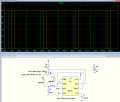Hi all,
Somewhat new to electronics. I studied mechanical engineering and learned a lot of electronic principles in some EE courses but very little hands on application outside of solving drawn circuits.
I am trying to build a speed controller using the following circuit with a CMOS 555 timer for power conservation:

I don’t have a potentiometer so I wired pin 7 directly the node between Ra and Rb. I also don’t have a 10nf cap so I am using a 100nf off of pin 5.
Instead, I tested the model with the following R values:
1)
Ra = 10K
Rb = 10K
C = 50nF
2)
Ra = 10K
Rb = 100K
C = 50nF
3)
Ra = 100k
Rb = 10k
C = 50nF
For some reason all 3 of these setups are resulting in the same RPM/motor voltage drop of 2.5V when providing a 3.3V power supply.
Circuit link:
https://www.electronics-tutorials.ws/blog/pulse-width-modulation.html
Can anyone see a problem with the circuit design/ a reason why changing these values is not changing the motor speed/voltage drop?
My end goal is a specified RPM, so if omitting the pot is my problem, how can I set the circuit up once the R values are defined to omit the pot for a constant specified motor speed?
Thank you!!
Sophia
Somewhat new to electronics. I studied mechanical engineering and learned a lot of electronic principles in some EE courses but very little hands on application outside of solving drawn circuits.
I am trying to build a speed controller using the following circuit with a CMOS 555 timer for power conservation:

I don’t have a potentiometer so I wired pin 7 directly the node between Ra and Rb. I also don’t have a 10nf cap so I am using a 100nf off of pin 5.
Instead, I tested the model with the following R values:
1)
Ra = 10K
Rb = 10K
C = 50nF
2)
Ra = 10K
Rb = 100K
C = 50nF
3)
Ra = 100k
Rb = 10k
C = 50nF
For some reason all 3 of these setups are resulting in the same RPM/motor voltage drop of 2.5V when providing a 3.3V power supply.
Circuit link:
https://www.electronics-tutorials.ws/blog/pulse-width-modulation.html
Can anyone see a problem with the circuit design/ a reason why changing these values is not changing the motor speed/voltage drop?
My end goal is a specified RPM, so if omitting the pot is my problem, how can I set the circuit up once the R values are defined to omit the pot for a constant specified motor speed?
Thank you!!
Sophia








